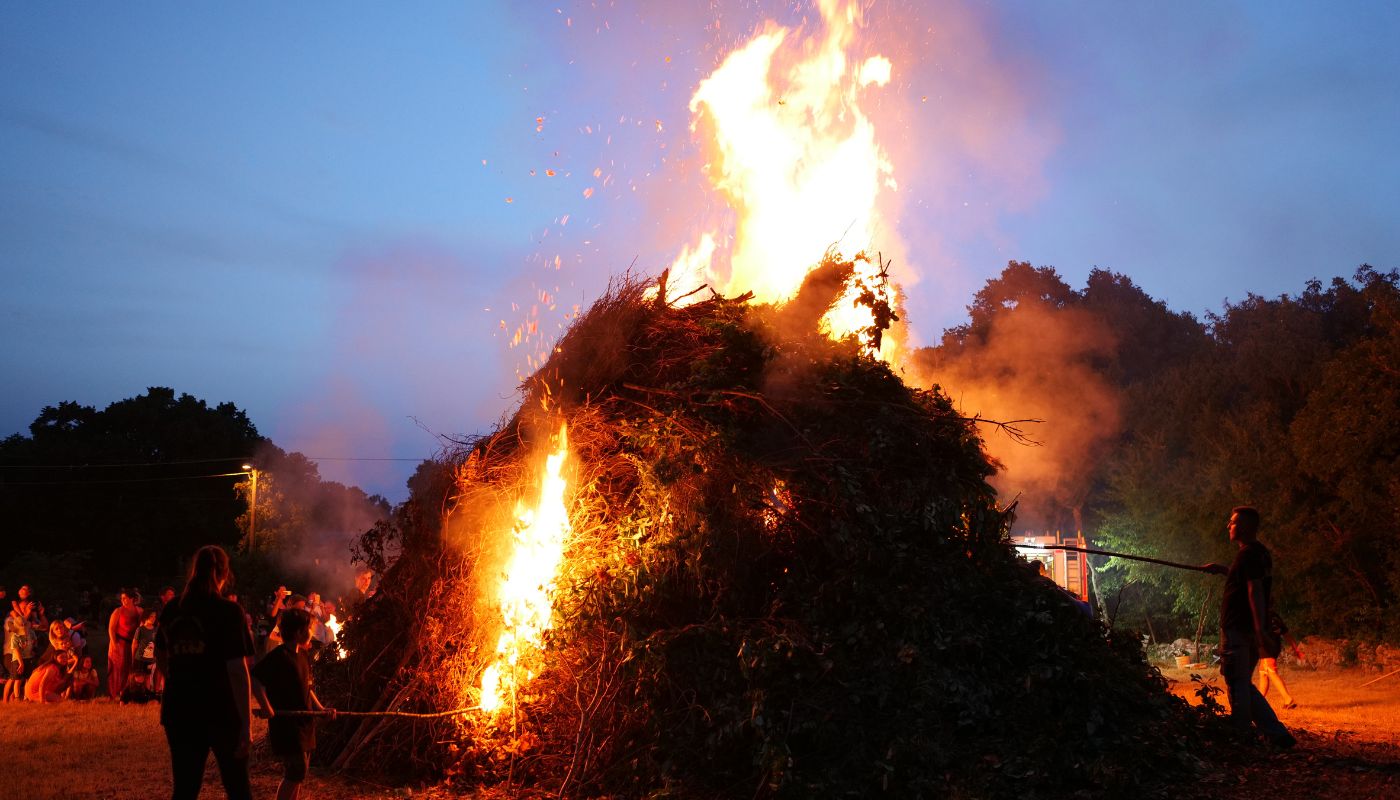
THE NIGHT OF ST. JOHN, ANCIENT RITES BETWEEN MAGIC AND RELIGIOSITY
by SARA TERPIN
The night between 23 and 24 June is in the tradition of several European populations a magical night: the summer solstice is celebrated, which in the Christian world has become the feast of St. John, moving the date of the celebrations by a few days.
In Slovenia, the feast of the Christian saint overlapped with ancient pagan rites, at the center of which was Kresnik (“Svetovit” for the ancient Slavs), deity of the sun. Also thanks to the assonance of the names, among the Slovenes Christianity had an easy time replacing the figure of Kresnik with that of the Baptist, who in Slovene is called “Krstnik” (from “krst” = baptism). The ancient deity of Kresnik was therefore supplanted by that of Janez Krstnik, but this was not enough to erase a whole series of rites and customs of pagan origin, with countless variations in the individual Slovenian regions. According to ethnologist Niko Kuret, the extraordinary richness of the rites of St. John’s night is like a sort of cross-section of human history that reveals its stratifications through the millennia.
“Šentjanževo” or “noč svetega Ivana” (“St. John’s night”) is still a very popular holiday in Slovenia, but also in the countries across the border where the Slovenian community lives: for example, in Benečija, where during this magical night in many villages large bonfires are lit, called “kries” (“kres” in Slovenian – note the assonance with Kresnik).
One of the kries The most famous is that of Tribil Superiore – Gorenji Tarbij, the highest hamlet (650 m above sea level) of the municipality of Stregna – Sriednje, where about forty inhabitants live, who however keep alive the tradition and rituals that have been handed down by grandparents and great-grandparents, who in turn repeated ancient gestures, often without knowing the deeper meaning.
Where does the kres tradition actually come from? And why are these fires lit on the night between 23 and 24 June? During the summer solstice the sun reaches its peak, but this also means that from this point its strength will decrease day by day. Man’s desire was to prolong the power of the sun as much as possible, “helping” it and giving it strength by lighting large fires, usually on the heights, so that it could be as close as possible to the sky.
In many countries, the collection of fireworks itself is a sort of ritual: young people go from house to house to collect waste wood and twigs and all families must contribute according to their availability.
According to custom, around the kres people dance and sing (in ancient times they were ritual songs of pagan origin praising the sun), but also jump over the fire to take advantage of its powers of purification. In addition to the kres, it was also customary to light “fiery wheels”, which were rolled down from the hills, or the “šibe”, fiery wooden tablets thrown into the air, also known by the Friulian tradition under the name of “cidulis” (which, however, are thrown for the winter solstice). The launch of the “šiba” is accompanied by invocations to the saints, dedications to the beloved girl or criticism of the villagers.
In addition to kries, another special feature of the rites of St. John in Upper Tribil – Gorenji Tarbij are the “križci” (crosses) and “krancelni” (garlands), which are woven with special flowers and wild herbs and then hung on the front door of houses to protect them. Legend has it that St. John himself would then go on to bless these garlands, whose herbs are burned to ward off storms.
The custom of the chaplets of St. John (“venčki Svetega Ivana”) is still alive and much loved even in other Slovenian communities, from the Brda to the Karst. In recent years, the chaplets of St. John in Štanjel have become very popular, and in 2000 they were included in the Inventory of Slovenian Cultural Heritage.
The crowns are not made with just any flowers, but with specific plants, well codified by tradition, with some characteristics in common: they have therapeutic properties, their flowers are star-shaped and the prevailing color is yellow. All aspects that refer to the sun and the deity who represented it for the ancient Slavs: Kresnik.
According to tradition, the powers of these plants are further enhanced during the summer solstice, taking on “magical” characteristics. The most “typical” plants of the rites of St. John are St. John’s wort (called “šentjanževka”, St. John’s wort), goat’s beard (Aruncus Dioicus, in Slovenian “navadno kresničevje”), daisy (which in Slovenian is called “ivanjščica”, St. John’s flower), elderberry and especially fern. It is said that those who have fern seeds in their pocket on St. John’s night can understand the language of animals (which would also have a divinatory meaning, since, according to tradition, on this night animals talk about what the future will be like). In some villages, the floors of the house and the stable are covered with fern, because St. John will lie down there to sleep, thus bringing blessing to the whole family.
The herbs collected during the night of St. John, macerated in water, oil or alcohol, become medicines to be used throughout the year. The remains of the flowers and stems used to weave the crowns are not thrown away, but are soaked in water which, according to tradition, is then used to wash because it has rejuvenating properties.
In addition to fire and herbs, water is another key element of the rites related to the night of St. John. According to tradition, on this night all water sources become “blessed” and immersion in them brings health and well-being. Dew also has a magical power: in Benečija, as well as in some villages in Slovenia, women spread a cloth on the grass on St. John’s night to collect the dew. The next morning they wring out the cloth and keep the precious liquid in bottles to be used as medicine if necessary.
The summer solstice was also an opportunity to predict the future. Countless divination rites used in various regions of Slovenia have been handed down to us. The most common are those practiced by girls to know when and with whom they will get married. According to a tradition in the Vipava Valley, at midnight on St. John’s Eve, by placing a bucket of water under the window, the girl would see the face of her future husband in it.
Another custom, also linked to the cult of fertility, is to plant wheat seeds in a pot. Based on how it sprouted, it was possible to predict whether there would be happy or tragic events in the house.
This magical night was also propitious for finding hidden treasures. By uprooting a fern plant at midnight, a gold ring could be found on the root. According to an ancient popular tradition, walking at midnight with a frog’s rib, three grains of salt and the hair of nine cats in his pocket, a small green light would appear that would guide the lucky one to a huge treasure.
A very special figure in the rites of St. John in Slovenia is that of the “kresnice” or “ladarice” (named after the Slavic goddess Lada, protector of love and health). According to this custom, which is preserved today mainly in the Bela Krajina region, small groups of girls dressed in white and with their faces covered by a handkerchief go singing through the fields at night, accompanied by a boy who plays the flute, and when they arrive in the village, they visit all the houses, never ceasing to sing songs of blessing for the men and the harvest. In return, they receive food or money as a gift, which they use at the end of the feast of St. John in a convivial banquet.
Originally, this rite took place not only on the night of St. John, but also on the previous ones: according to tradition, in fact, the fields and the harvest had to be protected from the forces of evil that in the period around the summer solstice were particularly insidious.
The kresnice, like the other summer solstice rites widespread among Slovenians, reflect a peasant culture strongly linked to the cycles of nature, in which survival depended on the harvest, which had to be protected at all costs. The mixture of Christian and pagan elements only increases the charm of these customs, in which we can find, hidden by the patina of time, traces of an ancient past that still lives on every year, for a single, magical night.
La lingua originale di questo articolo è l'Italiano.

